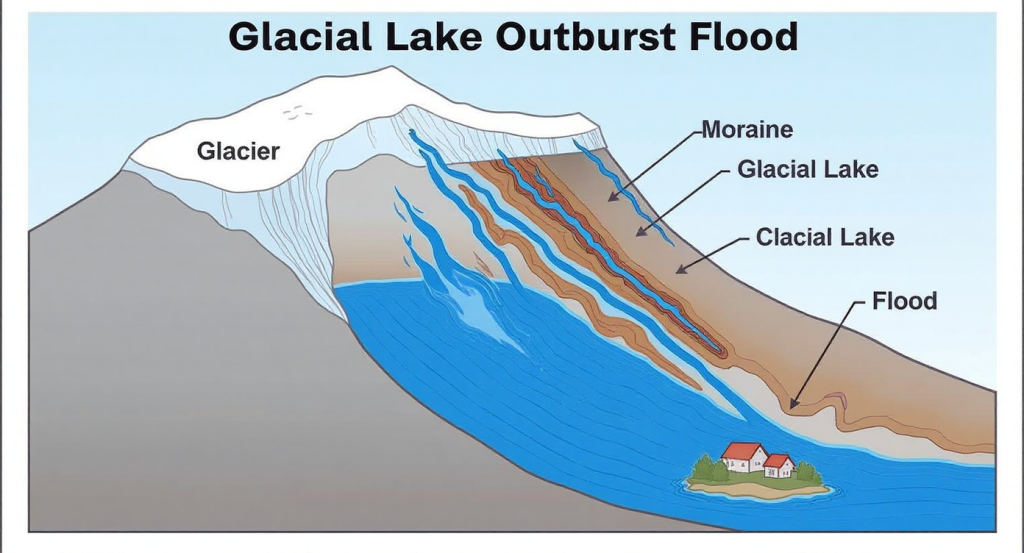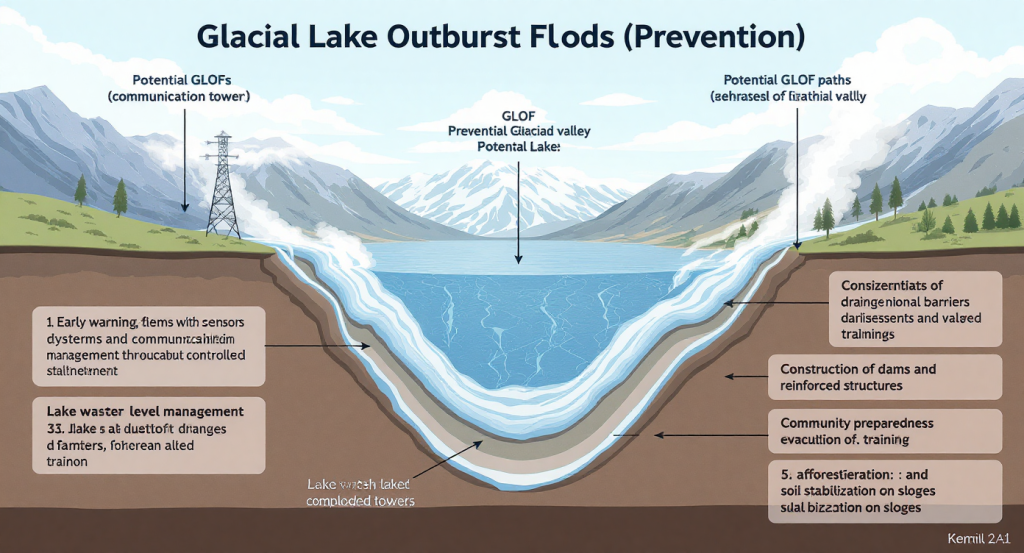Gilgit-Baltistan, one of the most beautiful places on earth with glaciers, valleys, and mountains, is dealing with a catastrophic environmental disaster of Glacial Lake Outburst Floods (GLOFs). The floods are occurring with increased frequency as temperatures rise and weather patterns shift. In June 2025, Pakistan’s disaster management agency issued high-level warnings that several valleys in the region are at high risk. It is serious, and communities must move quickly to mitigate harm. This blog examines the cause, risk factors, government response, and what communities can do to prepare.
What Are GLOFs and Why Are They Dangerous?

A GLOF occurs when a lake produced from glacial melting is released, destroying a natural dam. These blockages are typically constructed of soil, rock, or ice that may give way once built up. When the water is released all at once, it cascades down the valleys, taking everything in its path: homes, crops, livestock, roads, and, often, lives. GLOFs can be sudden or limited-notice events, posing a particularly high risk to those living in remote, high-altitude regions.
The threat is particularly acute in Gilgit-Baltistan, which has over 7,000 glaciers and approximately 3,000 glacial lakes. Many of these lakes are growing rapidly because of the increased temperatures and longer periods of heat waves. Dozens of them have already been found to be particularly exposed to sudden flares, experts have identified.
Current Situation in June 2025
Gilgit-Baltistan has seen record high temperatures over the past few weeks, with temperatures 5 to 7 degrees Celsius above average. Searing heat, powerful monsoon systems, and westerly winds are accelerating the melting. Glacial lake water levels have surged. National agencies have also issued GLOF alerts at different valleys, including Reshun, Brep, Booni, Sardar Gol, Thalu, Badswat, Hinarchi, Darkut, and Hand Under.
Recent flash floods in the area have already torn up streets, destroyed houses, and derailed tourism. In one instance, flooding near Attabad Lake affected hotel access roads, and in another, in Skardu’s Barga Nallah, there were immense property and agricultural losses. Officials have told residents and visitors to stay out of glacial areas and not spend the night near rivers amid concerns that they could be subject to water surges.
Community Preparedness: What Can Residents Do?

Local awareness and preparedness are crucial in areas threatened by GLOFs. Risk must be minimized through proactive communities. Communities should define the closest safe spots on high ground and establish unambiguous evacuation routes before any eventuality. Stores of water, food, medication, flashlights, and waterproof bags of important documents should be kept ready at all times.
Residents shall join training courses and emergency drills regularly launched by local governments. It’s also important to stay informed with battery-operated radios, or through trucked-in mobile apps, to get weather updates and evacuation alerts.
Evacuation during a GLOF. The Time frame for evacuation during a GLOF is immediate or at higher coverage. Lives are at stake in waiting for official confirmation. Local communities should assist elderly residents, women, children, and people with disabilities in escaping to safety. They recommend clearing bridges and roads along rivers, where floodwaters can destroy.
Be cautious even after floodwaters have receded. Residents should not re-enter damaged homes until a green placard has been issued, and they should help others with the clean-up and recovery. Informing the local authorities about the lost or missing people and the broken-down infrastructure will facilitate help and repair soon. Collective effort makes all the difference at every stage: before, during, and after an emergency or disaster.
Climate Change: The Real Culprit
The rise in GLOF events is not a mere reflection of individual weather shifts; it’s a clear sign of climate change. The temperature in northern Pakistan has soared over the years. What had historically been stable glaciers year-round are now in full retreat. As they melt, they create unstable lakes susceptible to heavy rain or a sudden spike in temperature.
Pakistan accounts for less than one percent of global carbon emissions but is listed as one of the top ten countries affected by weather-related disasters. Here’s an instance of climate injustice: The people of Gilgit-Baltistan, with their insignificant carbon footprints, are the victims of climatic change occurring elsewhere.
Compounding the problem is that high-risk areas lack adequate infrastructure. Most villages are not protected by the floods, drains, or emergency shelters they need. Communication systems in remote mountain valleys are often so poor that it is hard to deliver timely warnings. Climate adaptation financing from abroad has also been slow and paltry, and many communities remain vulnerable.
What Is the Government Doing?
Both the national and provincial governments have taken various measures to respond to the increasing threat. The NDMA, PDMA, and some emergency services, including Rescue 1122, have sent out official alerts and are gearing up for evacuations, if necessary. Field teams have been dispatched to monitor glacial lakes and rivers. Sirens, alarms, emails, and mobile alerts are being employed to keep people informed.
Pakistan is also collaborating with international initiatives on a wider scale through the GLOF-II project. The Green Climate Fund and UNDP-backed project aims to build community resilience. This encompasses setting up early warning systems, building protective infrastructures, and educating local volunteers about how to lessen risk. New visits by climate officials and international agencies are helping coordinate a better response. Still, the implementation on the ground has been difficult so far because of difficult terrain and funding shortfalls.
A Call for Global Responsibility
The GLOF threat is yet another reminder that climate change is not a problem somewhere distant in the future; it is happening now and ripping through communities that have done the least to cause it. The international community is obligated to assist Pakistan with relief aid after disasters and long-term climate financing and adaptation tools. These features advance in weather forecasting, safer buildings, and learning in high-risk places.
Pakistan should also invest more in supporting capacity locally. Increasing the number of rescue teams, enhancing systems for communicating disasters, and constructing sturdier homes and roads can help greatly. Climate Resilience Should be a National Priority, Focusing on those most Vulnerable in the North.
Conclusion
The recent GLOF alerts in Gilgit-Baltistan are not isolated seasonal threats but indicative of a larger environmental catastrophe. Glaciers are melting unprecedentedly, and unstable lakes are imperiling lives and livelihoods. High risk does not necessarily mean irreversible harm. The people of Gilgit Baltistan can be saved through proper planning, early warnings, community awareness, and global collaboration.
We need to act now, not just here but everywhere. The mountains are now calling for film justice, not travel or tourism.
